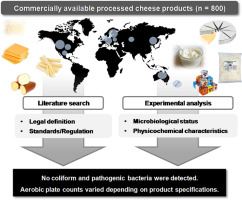Food Research International ( IF 7.0 ) Pub Date : 2018-01-10 , DOI: 10.1016/j.foodres.2018.01.014 Nam Hee Kim , Na Young Lee , Min Gyu Kim , Hye Won Kim , Tae Jin Cho , In Sun Joo , Eun Jung Heo , Min Suk Rhee

|
Although global cheese manufacturers release a variety of products onto the market, research on the microbiological quality and safety of cheese has focused mainly on conventional cheeses made from milk. Here, this study aimed to investigate commercially processed cheese products produced by mixing conventional cheeses after melting. Two approaches were used: a summary and comparison of legal definitions and standards/regulations regarding the microbiological criteria used by major cheese traders in the global market (Australia/New Zealand, China, European Union, Japan, Mexico, Republic of Korea, and the United States) and a comprehensive microbiological analysis of commercial products (n = 800), along with an assessment of salinity, pH, water activity, and heating conditions. The results of the literature search showed that major importing countries (China, Japan, Mexico, and the Republic of Korea) have stricter microbiological criteria for commercially available cheese products than major exporters (Australia/New Zealand, EU, and the USA). The former set limits with respect to the number of total coliforms in the product. Microbiological analyses were designed according to global standards and recommendations. No test sample contained detectable levels of Clostridium perfringens, enterohemorrhagic Escherichia coli, Listeria monocytogenes, Salmonella, or Staphylococcus aureus. In addition, no coliform bacteria (including E. coli) were detected. Overall, 79.9% of the samples contained detectable aerobic plate counts (1.0–7.8 log CFU/g); these levels varied significantly according to product type (grated cheese > chunks; cream cheese > portions or sliced) (p < .05). There was no significant association between microbe levels and salinity, water activity, pH, and heating conditions. The results can be used to develop a comprehensive database about commercially processed cheese products available in the global market and, as such, may be helpful for both national authorities and cheese manufacturers when considering novel strategic management plans for microbiological quality and safety.











































 京公网安备 11010802027423号
京公网安备 11010802027423号